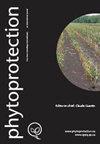Antagonistic potential of native agrocin-producing non-pathogenic Agrobacterium tumefaciens strain UHFBA-218 to control crown gall in peach
IF 0.2
4区 农林科学
Q4 PLANT SCIENCES
引用次数: 5
Abstract
A non-pathogenic agrocin-producing native isolate of Agrobacterium tumefaciens strain UHFBA-218 was tested as a biological control agent against the peach crown gall. This strain was compatible with all the recommended pesticides used in stone fruits in the integrated pest management (IPM) module, except for copper oxychloride, which was detrimental to its growth. Upon artificial co-inoculation of 4-wk-old plants of tomato var. Solan Gola with A. tumefaciens strain UHFBA-218 and tumorigenic A. tumefaciens strain Peach 2E-10, out of the 27 isolates recovered, six were transconjugants showing selective acquisition of tumorigenic factors as made evident by amplification with ipt and virD2 primers, whereas the rest of the isolates did not acquire any of these tumorigenic factors. A white stone powder-based formulation of this isolate (103.3 × 108 cfu g-1) retained appreciable viability for up to 6 months at room temperature. When peach roots and seeds were soaked in cell suspensions of different doses of a white stone powder-based bioformulation of UHFBA-218 before planting in the field, the number of plants with tumours was reduced, with the lowest incidence of crown gall being observed in the 0.1% UHFBA-218 root dip treatment, i.e. 1.48% and 0.80% during the years 2013 and 2014, respectively. No incidence of crown gall was observed in the three seed dip treatments, i.e. 30-min dip in UHFBA-218 followed by 1 h of shade drying, stratified seeds dipped for 30 min in 0.1% suspensions of strains UHFBA-218 or K84 followed by 1 h of shade drying before sowing, as compared with 14.76% incidence in untreated plants.产农蛋白非致病性农杆菌UHFBA-218对桃树冠瘿病的拮抗作用
研究了一株产农蛋白的农杆菌UHFBA-218原生分离物作为防治桃冠瘿病的生物防治剂。该菌株与核果综合治理(IPM)模块中推荐使用的所有农药均兼容,但对其生长有害的氯氧化铜除外。将番茄品种Solan Gola的4周龄植株与产瘤假丝酵母菌UHFBA-218和致瘤假丝酵母菌Peach 2E-10人工共接种后,在27株分离株中,有6株通过ipt和virD2引物扩增得到了选择性获得致瘤因子的转接合物,而其余分离株没有获得任何致瘤因子。该分离物的白色石粉配方(103.3 × 108 cfu g-1)在室温下可保持可观的活力长达6个月。种植前将桃根和种子浸泡在不同剂量的UHFBA-218白色石粉生物制剂的细胞悬浮液中,可减少肿瘤植株的数量,其中0.1% UHFBA-218根浸处理的树冠瘤发生率最低,2013年和2014年分别为1.48%和0.80%。在UHFBA-218中浸种30 min后阴晒1 h,在UHFBA-218或K84的0.1%悬浮液中分层种子浸种30 min后阴晒1 h后播种,三种处理均未发现冠瘿发生,而未处理植株的冠瘿发生率为14.76%。
本文章由计算机程序翻译,如有差异,请以英文原文为准。
求助全文
约1分钟内获得全文
求助全文

 求助内容:
求助内容: 应助结果提醒方式:
应助结果提醒方式:


